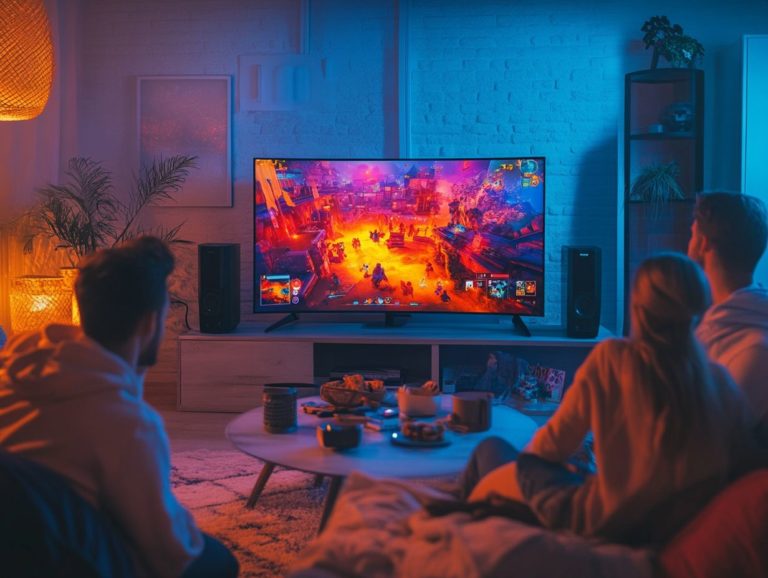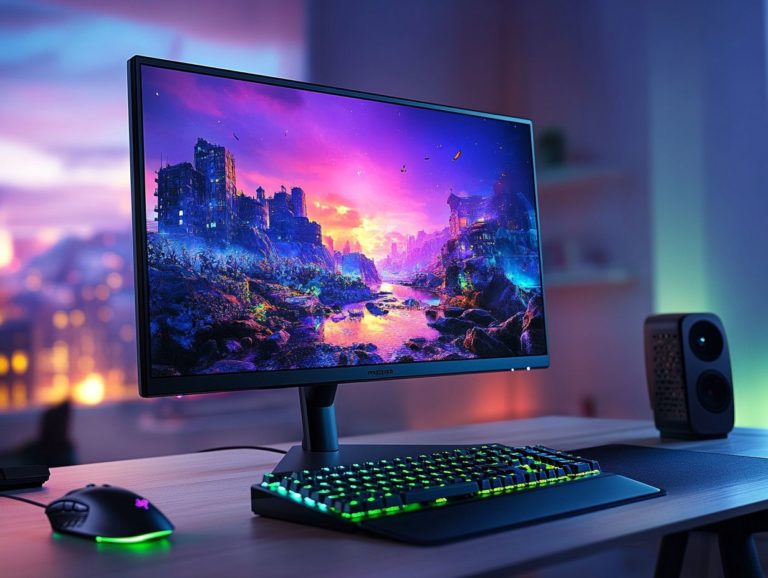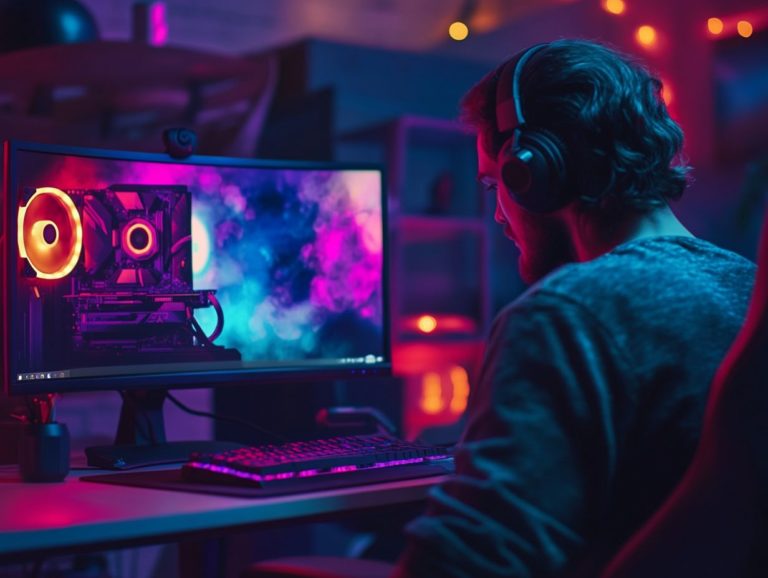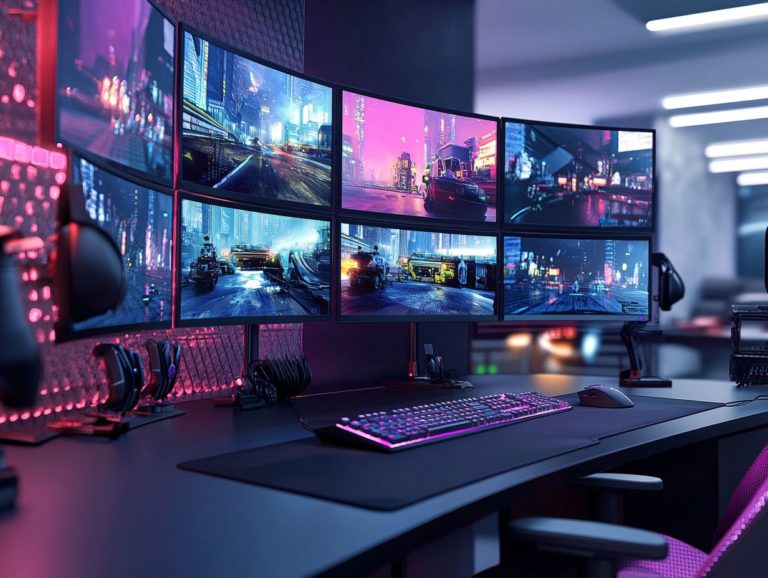5 tips for choosing a monitor for streaming
Choosing the right monitor can transform your streaming experience!
Whether you re a casual viewer or an aspiring content creator, understanding key features like resolution, refresh rate, and color gamut is important.
This guide offers five tips for choosing the perfect monitor. We cover screen size, type, and connectivity options.
It also highlights common pitfalls to avoid and gives budget-friendly recommendations. This helps you make a smart choice.
Contents
- Key Takeaways:
- 1. Consider the Resolution and Aspect Ratio
- 2. Look for a High Refresh Rate
- 3. Check for Wide Color Gamut Support
- 4. Consider the Size and Screen Type
- 5. Look for Additional Features and Connectivity Options
- What Is the Best Resolution and Aspect Ratio for Streaming?
- What Is the Ideal Refresh Rate for a Streaming Monitor?
- How Does Color Gamut Affect Streaming Quality?
- What Are the Pros and Cons of Different Screen Types for Streaming?
- What Are Some Additional Features to Look for in a Streaming Monitor?
- How Can Connectivity Options Impact Streaming Performance?
- What Are the Most Common Mistakes to Avoid When Choosing a Streaming Monitor?
- What Are Some Budget-Friendly Options for Streaming Monitors?
- How Can a User Optimize Their Streaming Monitor for the Best Viewing Experience?
- What Are the Key Differences Between a Gaming Monitor and a Streaming Monitor?
- What Are the Advantages of Using Multiple Monitors for Streaming?
- Frequently Asked Questions
- What are the top 5 tips for choosing a monitor for streaming?
- How important is screen size when choosing a monitor for streaming?
- What is the ideal resolution for a streaming monitor?
- Can I use a TV as a monitor for streaming?
- Are there any specific features I should look for in a streaming monitor?
- Is it worth investing in a curved monitor for streaming?
Key Takeaways:
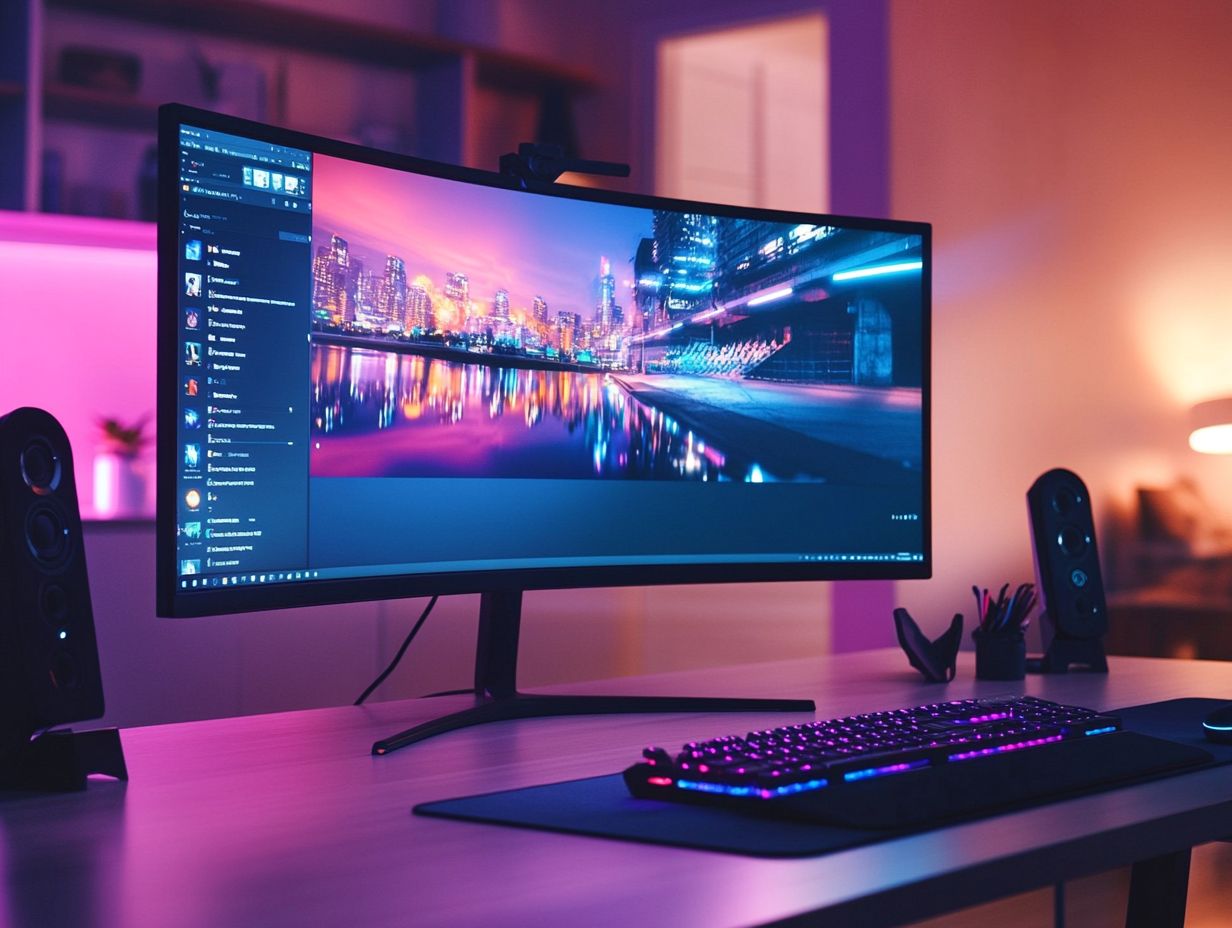
- Resolution affects content clarity.
- High refresh rates ensure smooth visuals.
- Wide color support creates vibrant images.
1. Consider the Resolution and Aspect Ratio
When selecting a monitor for streaming content, it s key to consider both resolution and aspect ratio.
These elements enhance viewer engagement and help content creators showcase their work compellingly.
With options like 1080p, 1440p, and 4K, each resolution offers distinct advantages. 1080p provides solid clarity, while 1440p and 4K elevate the experience with sharper details perfect for gamers who crave immersive visuals.
Aspect ratios, especially the standard 16:9, deliver a balanced display that accommodates most media formats. This layout pleases the eye and supports multitasking, which is vital for productivity.
Creating a customizable workspace boosts your efficiency, allowing you to arrange your tools and applications for seamless transitions between tasks. This makes your streaming sessions more enjoyable and productive.
2. Look for a High Refresh Rate
A high refresh rate is essential for optimal streaming, delivering smoother visuals and enhancing engagement during online sessions.
Refresh rates of 144Hz or even 165Hz minimize motion blur, crucial during fast scenes or quick movements.
These rates determine how many times per second the image on your screen is refreshed, offering a clearer visual experience.
Take the ASUS ROG Swift PG259QN, for instance, with its impressive 360Hz refresh rate; it showcases this technology brilliantly, helping you react swiftly during intense gameplay.
Similarly, the Acer Predator XB273 X, boasting a 144Hz rate, elevates both competitive action and cinematic experiences, allowing you to immerse yourself fully without distractions.
3. Check for Wide Color Gamut Support
Wide color gamut support is crucial when selecting a monitor, as it significantly enhances visual performance.
This feature provides richer colors and an elevated viewing experience, especially for streaming content creators.
With this technology, you gain more accurate color reproduction, essential for crafting high-quality visuals. By incorporating standards like Adobe RGB and DCI-P3, monitors can display a broader spectrum of colors, resulting in vibrant images that align with your creative vision.
For streaming applications, this translates to lifelike visuals that enhance viewer engagement. Rich, accurate colors can be the deciding factor between a good stream and an exceptional one, boosting your credibility as a creator and elevating your audience’s enjoyment.
In conclusion, choosing the best monitors for game streaming is vital for your streaming needs. With these tips, you can make an informed decision that enhances your viewing experience and supports your creative endeavors.
4. Consider the Size and Screen Type
When choosing a streaming monitor, the size and screen type are pivotal in shaping the usability and effectiveness of your streaming setup. Opting for larger screens or a dual monitor configuration can significantly expand your screen real estate. This enhances your ability to work on multiple tasks at once while you stream.
By exploring various screen sizes, you can discover the optimal dimensions that elevate your viewing experience. Consider IPS panels, which show colors better and have wider viewing angles, making them ideal for detail-oriented tasks. If you want faster response times, TN panels are a solid choice for competitive gaming.
Setting up a dual or triple monitor arrangement gives you the power to transition effortlessly between different applications, including live streaming software, editing tools, and chat interfaces. This setup streamlines your workflow and cultivates a more efficient environment. It allows you to focus on content creation without interruption.
5. Look for Additional Features and Connectivity Options
Exploring additional features and connectivity options can significantly elevate your streaming experience. Look for features like low input lag and multiple HDMI or DisplayPort inputs, which facilitate seamless streaming and enhance your content creation efforts.
When you’re piecing together the ideal setup, adjustable stands can prove invaluable. They allow you to find that perfect viewing angle during those marathon editing sessions. Built-in speakers free you from the hassle of external audio solutions, delivering crisp sound right out of the box.
Picture-in-picture modes give you the power to multitask with ease. This keeps chat windows or reference materials visible while you dive into your projects. Connectivity options like USB-C and Bluetooth simplify integration with cameras, microphones, and other essential devices.
These enhancements refine your streaming experience and streamline your workflow, making content creation smoother and much more enjoyable.
What Is the Best Resolution and Aspect Ratio for Streaming?
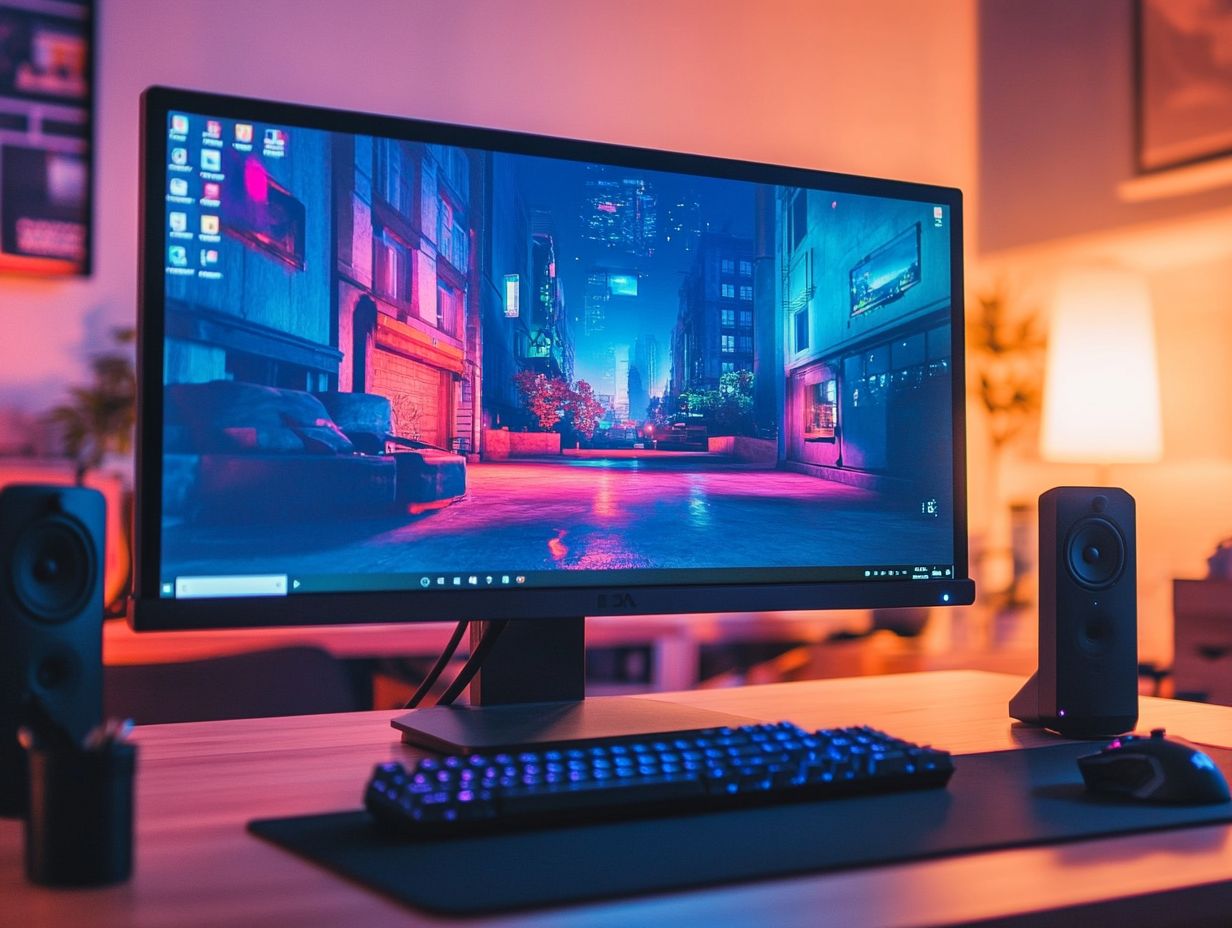
Determining the best resolution and aspect ratio for streaming requires a keen understanding of your specific needs as a content creator and those of your audience. Find that sweet spot now for the best streaming experience!
It s about balancing visual clarity and viewer engagement while ensuring compatibility with platforms like Twitch and YouTube.
Among your options, 1080p stands out as an excellent choice. It strikes a perfect balance between quality and accessibility, making it ideal for gamers and vloggers who want crisp visuals without heavy bandwidth demands.
If you want an immersive experience, go for 4K resolution. It’s especially beneficial for cinematic content or detailed tutorials that captivate viewers with stunning detail.
Don t underestimate the importance of aspect ratio in defining the viewing experience. The traditional 16:9 format works seamlessly across most platforms, while the wider 21:9 aspect ratio can enhance cinematic storytelling, making your content feel more engaging.
Ultimately, choosing the right resolution and aspect ratio significantly impacts viewer retention. After all, viewers are more likely to stick around for visually appealing content that resonates with their preferences.
What Is the Ideal Refresh Rate for a Streaming Monitor?
The ideal refresh rate for your streaming monitor typically hovers around 60Hz for standard streaming. However, if you’re a content creator or a gamer chasing high-speed visuals, consider monitors with refresh rates of 144Hz or higher for a truly seamless experience.
This distinction in refresh rates can significantly enhance your viewing pleasure, especially when you’re engrossed in fast-paced action films or competitive gaming.
For instance, a monitor with a 240Hz refresh rate can deliver an exceptionally fluid experience, making it a favorite among gamers who demand precision and responsiveness. Models like the ASUS ROG Swift PG259QN and the Dell Alienware AW2521H are excellent choices, crafted specifically for enthusiasts like you.
If your primary focus is streaming series or movies, a solid 60Hz display such as the LG 27UK850-W might be just what you need. It offers vibrant colors and remarkable picture quality, catering perfectly to casual viewers.
Ultimately, your choice boils down to the type of content you enjoy consuming.
How Does Color Gamut Affect Streaming Quality?
Color gamut refers to the range of colors a device can display. It plays a pivotal role in streaming quality by ensuring that the colors you see are both accurate and vibrant.
This significantly enhances the visual performance of content and captivates your attention. Different color spaces, like sRGB, Adobe RGB, and DCI-P3, each bring unique characteristics to how colors are rendered across various devices.
When creators utilize a wider gamut such as DCI-P3, they capture a broader spectrum of hues. This leads to more lifelike and immersive experiences for you as the viewer.
However, if your playback device only supports a narrower color space, you might miss out on the intended vibrancy. This could result in colors appearing dull or inaccurate.
Understanding the relationship between recording methods and your viewing equipment’s capabilities is essential for optimizing streaming quality.
What Are the Pros and Cons of Different Screen Types for Streaming?
Understanding the advantages and disadvantages of different screen types like IPS, TN, and VA panels is vital for a top-notch streaming setup!
Each panel type has unique characteristics that significantly impact your experience. If you value vibrant color accuracy and wide viewing angles, IPS panels are your best bet, perfect for enjoying movies and shows with friends or family.
If you’re a gamer, you might lean toward TN panels. These are known for their rapid response times, enhancing gameplay and minimizing lag during intense moments.
Then there are VA panels, which strike a balance by offering superior contrast ratios and deeper blacks. This elevates your immersive experience in darker settings.
By considering these attributes, you can tailor your monitor choice to align perfectly with your specific streaming preferences and environment.
What Are Some Additional Features to Look for in a Streaming Monitor?
Additional features in a streaming monitor can dramatically boost your streaming experience!
Options like adjustable stands, built-in USB hubs, and advanced color calibration create a customizable workspace that’s perfect for content creators.
Flicker-free technology can drastically reduce eye strain during those marathon streaming sessions, keeping you focused and comfortable.
Customizable profiles let you make quick adjustments between different tasks, making it seamless to transition from gaming to video editing.
Picture-in-picture modes are a game-changer for multitasking, allowing you to monitor chat interactions or additional content without sacrificing valuable screen space.
These features help you boost your productivity, ultimately leading to a more engaging and polished output for your audience.
How Can Connectivity Options Impact Streaming Performance?
Connectivity options are essential for streaming performance. Having HDMI, DisplayPort, and minimal input lag can greatly influence the overall quality of your experience.
Connecting a variety of devices is crucial for seamless integration across platforms, whether you’re using gaming consoles, PCs, or even mobile devices. This versatility allows you to switch between devices effortlessly.
The impact of input lag is particularly significant, especially for gamers and streamers; even a fraction of a second can affect your reaction times and overall enjoyment.
When choosing monitors, prioritize those designed with lower input lag to enhance your gameplay responsiveness. In today s fast-paced digital landscape, these factors can truly make a difference in your performance and enjoyment.
What Are the Most Common Mistakes to Avoid When Choosing a Streaming Monitor?
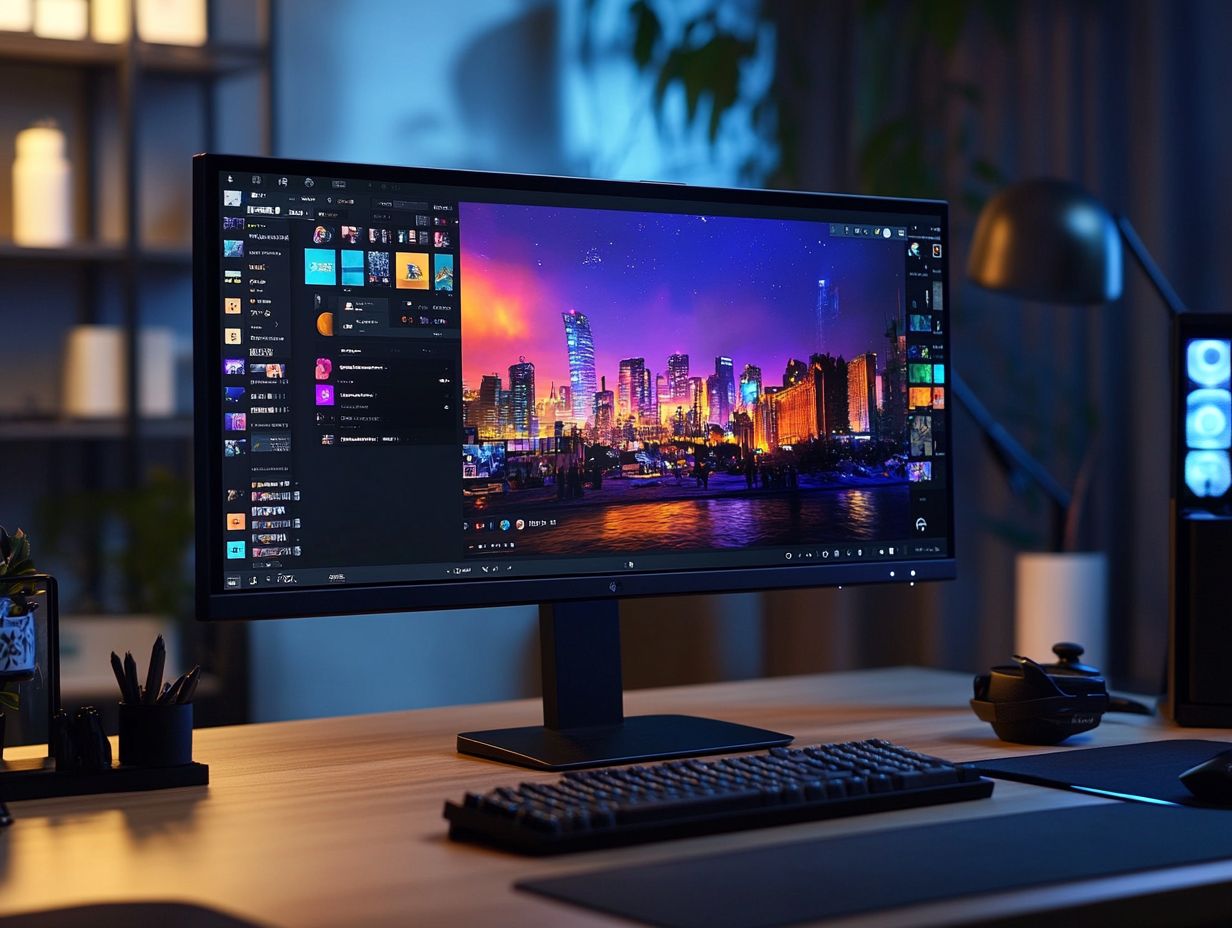
By steering clear of common pitfalls when selecting a streaming monitor, such as overlooking resolution and refresh rate, you can significantly enhance the effectiveness of your setup. For instance, checking out the best monitors for streaming and gaming ensures a more enjoyable experience for both you and your audience.
Many buyers often overlook how important color accuracy is, which plays a crucial role in delivering a vibrant and engaging visual experience. Choosing the wrong panel type, such as a TN panel (Twisted Nematic) instead of an IPS (In-Plane Switching), can severely compromise both viewing angles and color fidelity.
To make choices that truly cater to your unique streaming needs, prioritize monitors with high resolution and refresh rates while looking into panel details. By understanding the specific requirements based on the type of content you re streaming be it gaming or creative work you can make a more informed and satisfying purchase.
What Are Some Budget-Friendly Options for Streaming Monitors?
Finding budget-friendly options for streaming monitors can be tricky, but you need it to boost your streaming without breaking the bank!
With a plethora of brands and models available, it s crucial for you to evaluate which features matter most, like resolution, refresh rate, and panel type. Many affordable monitors now boast Full HD resolution, delivering a crisp and vibrant display for all your content.
If you’re into fast-paced gaming or action-packed scenes, a higher refresh rate can truly elevate your viewing experience. By focusing on these specifications, you can pinpoint options that offer the perfect balance between cost and performance, ensuring you get quality without overspending.
How Can a User Optimize Their Streaming Monitor for the Best Viewing Experience?
Optimizing your streaming monitor for the best viewing experience involves fine-tuning settings like brightness, contrast, and color calibration. These adjustments can significantly enhance engagement and viewer satisfaction.
In various contexts, such as gaming or video conferencing, specific tweaks can elevate your experience even further.
- For gaming, improving response time by adjusting settings like the refresh rate can make a world of difference.
- During video calls, refining sharpness and saturation can boost clarity and facial recognition, making conversations more engaging.
To achieve these precise adjustments, consider employing calibration tools like colorimeters or professional calibration software. Regularly revisiting these settings as lighting conditions in your environment change will help you maintain optimal performance, allowing you to fully immerse yourself in your favorite activities.
What Are the Key Differences Between a Gaming Monitor and a Streaming Monitor?
Understanding the key differences between a gaming monitor and a streaming monitor is crucial for you as a content creator. Gaming monitors typically emphasize refresh rates and response times, while streaming monitors prioritize color accuracy and viewing angles.
This distinction matters significantly because each type of monitor is designed to meet specific user needs. For gamers like you, a high refresh rate usually 144Hz or more combined with low response times, often around 1ms, enhances your gameplay experience, offering smoother visuals and minimizing motion blur.
On the other hand, if you’re a streamer, you’ll want monitors that provide exceptional color fidelity and wide viewing angles. This ensures that your stream appears vibrant and professional to viewers on various devices.
For example, the ASUS ROG Swift PG259QN is renowned for its gaming capabilities, while the Dell UltraSharp U2720Q excels in the streaming arena with its impressive color reproduction and IPS technology.
So, are you ready to upgrade your streaming setup? Let’s find the perfect monitor together!
What Are the Advantages of Using Multiple Monitors for Streaming?
Using multiple monitors for streaming has many benefits. It boosts productivity and improves multitasking.
With a dual or triple monitor setup, you can manage content, monitor chat interactions, and oversee your streaming software simultaneously. This gives you the power to switch between applications without a hitch.
Your viewers will love the high-quality visuals and real-time interactions. This creates an engaging environment where they can participate more.
These setups supercharge your workflow and enhance your connection with fans, elevating the quality of content for everyone involved.
Frequently Asked Questions
What are the top 5 tips for choosing a monitor for streaming?

The top 5 tips for choosing a monitor for streaming are:
- Consider the size and resolution of the monitor for the best viewing experience.
- Look for a monitor that refreshes quickly to prevent lag.
- Check compatibility with your streaming setup, including your graphics card and available connections.
- Consider color accuracy and contrast ratio for a vibrant display.
- Read reviews and compare prices to find the best value for your budget.
How important is screen size when choosing a monitor for streaming?
Screen size is crucial when choosing a monitor for streaming as it affects your viewing experience. Think about the distance between you and the monitor, as well as the details you need to see while streaming. For a more immersive display, opt for a larger screen size.
What is the ideal resolution for a streaming monitor?
The ideal resolution for a streaming monitor depends on the type of content you plan to stream. For gaming or video editing, a higher resolution like 4K is beneficial for sharper images and smoother gameplay. For general streaming, 1080p is usually sufficient and more budget-friendly.
Can I use a TV as a monitor for streaming?
While it’s possible to use a TV as a monitor for streaming, it may not provide the best experience. TVs often have higher input lag compared to monitors, resulting in a delay between your actions and what appears on screen. Additionally, TVs usually have lower refresh rates and are not optimized for computer use.
Are there any specific features I should look for in a streaming monitor?
Yes, certain features can enhance your streaming experience. Look for a built-in webcam for facecam streaming, an adjustable stand for comfort, and a USB hub for easy connectivity. Consider your streaming needs when choosing a monitor.
Is it worth investing in a curved monitor for streaming?
It ultimately depends on personal preference. A curved monitor can provide a more immersive viewing experience, as the curved design mimics the natural curvature of the eye, reducing eye strain. However, it may come at a higher cost and may not be necessary for everyone.


